REU Past Students
2023 2022 2021 2019 2018 2017 2016 2015 2014 2013 2012 2011
2017
-
Bridget Anger - Chemical Engineering, University of Maryland, Baltimore County
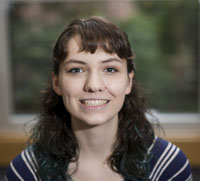 LinkedIn
LinkedIn
Educational Institution: University of Maryland, Baltimore County
List of Mentors: Dr. Kane Jennings & Max Robinson
Program: NSF REU
Research Project: Efficient Charge Separation in Composite Photosystem I/PEDOT Photocathodes Prepared by Vapor Phase Polymerization
Poster: NSF REU Bridget Anger.pdf
Research Abstract: Photosystem I (PSI) is a stable, abundant, and highly efficient photocatalytic protein that is found in photosynthetic organisms and has been utilized in solar cells and hydrogen fuel cells. This project incorporates an electrically conductive polymer, poly (3,4-ethylenedioxythiophene) (PEDOT), in a PSI:PEDOT composite film, developed through vapor phase polymerization. Introducing conductive PEDOT into the film facilitates highly directional electron transfer when used in a solar cell with electrolyte solution. When a PSI:PEDOT composite film on a gold electrode is paired with a methyl viologen mediator and electrolyte solution, photocurrents of 1.35μA/cm2 have been recorded. In an effort to improve charge separation and increase photocurrent, we performed tests with anion exchange of ferri/ferrocyanide ions in the composite films, but the experimental data showed that films with anion exchange produced ~0.612 μA/cm2, which was less than half of the photocurrent recorded with films that had no anion exchange. While we had initially thought that cycling in the redox ions would make a more energetically favorable path for the electrons, we now believe that the incorporation of these ions decreases the charge transfer efficiency. Moving forward, we then developed a solar device composed of a dye-sensitized mesoporous TiO2 anode and a PSI:PEDOT composite photocathode which produced anodic photocurrents around 100 μA/cm2. When this device was tested with different concentrations of PSI and a control with only PEDOT, there was a strong correlation with higher concentrations of PSI resulting in higher photocurrent.
- Conference Presentation
-B. Anger, M.T. Robinson, D.E. Cliffel, and G.K. Jennings “Efficient Charge Separation in Composite Photosystem I/PEDOT Photocathodes Prepared by Vapor Phase Polymerization” NCUR (National Conference on Undergraduate Research) Annual Meeting, Edmond, OK, April, 2018.
-B. Anger, M.T. Robinson, D.E. Cliffel, and G.K. Jennings “Efficient Charge Separation in Composite Photosystem I/PEDOT Photocathodes Prepared by Vapor Phase Polymerization” UMBC Meyerhoff Selection Weekend, Baltimore, MD, February, 2018 - Bridget was awarded a $1K travel grant at the capstone poster session.
- Conference Presentation
-
Mariah Arral - Chemical Engineering, University of New Hampshire
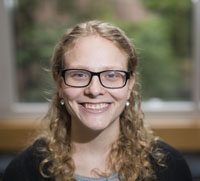 LinkedIn
LinkedIn
Educational Institution: University of New Hampshire
List of Mentors: Dr. Scott Guelcher & Tom Spoonmore
Program: NSF REU
Research Project: Characterization ofS. AureusGrowth and ToleranceDevelopmentin 2D and 3D in vitroModels
Poster: NSF REU Mariah Arral Poster.pdf
Research Abstract: Staphylococcus aureus is a common bacteria that can infect fractures and cause serious bacterial infections. Chronic infections can be attributed to the presence of bacterial cell communities that are tolerant to clinically relevant treatment. These communities can be defined as biofilms and are relate to 80% of human infections. The goal of our experiments is to understand if and when tolerance develops to treatment of vancomycin and rifampin on 2D and 3D convex substrates in a novel in vitro biofilm model. Along with tolerance we will examine how S. Aureus strain UAMS-1 grows on 2D and 3D convex surfaces over time. A second goal of our project is to characterize the ability of vancomycin and rifampin to eradicate infection when delivered through polyurethane foam carriers. From our experiments, we were able to conclude that regardless of seeding density and geometry bacterial cell communities grow to similar surface densities (LOG[CFU/cm 2 ]) after 24 hr. Vancomycin and rifampin tolerance studies proved that tolerant bacterial cell communities existed on the substrate surface following 24 hours of bacterial cell growth. We believe these tolerant cell communities to be biofilms based off the tolerant phenotype when exposed to vancomycin at concentrations up to 100 μg/mL. Interestingly, bacterial growth on 3D convex surface was found to have slower kinetic development of tolerance than bacterial infection on 2D surfaces, while the surface density of cells was determined to be similar. Finally, delivery of vancomycin and rifampin through polyurethane foams proved to inhibit bacterial growth on both the 2D substrate and the scaffold surface when delivered concurrently with inoculation. However, foams loaded with vancomycin or rifampin were unable to eradicate tolerant infections at 24 hours. Foams loaded with rifampin also became a nidus for infection when delivered to tolerant bacterial communities at 24 hours. Interestingly, foams loaded with 6 wt% vancomycin were able to inhibit the bacterial infection from spreading to the scaffold at 0, 6, and 24 hours, suggesting the ability to prevent biofilm cells from spreading to the scaffold surface.- Mariah was awarded a NSF Graduate Research Fellowship in 2018
-
Timothy Bernard - Mechanical Engineering, University of Maryland, Baltimore County
 LinkedIn
LinkedIn
Educational Institution: University of Maryland, Baltimore County
List of Mentors: Dr. Leon Bellan & Brian O'Grady
Program: NSF REU
Research Project: Retrofitting a Commercial 3D Printer for Bioprinting Capabilities
Poster: NSF REU Timothy Bernard Poster.pdf
Research Abstract: In order to create Lower Critical Solution Temperature (LCST) polymer frameworks with complicated 3D structures, we present a low-cost hardware and software adaptation for a commercial dual extrusion 3D printer. The modified printer uses the two existing thermoplastic extruders and adds a third pressure extruder with a blunt needle to extrude biocompatible materials. In addition, the software revises the conventional G-Code instructions for the triple-extrusion process. This allows for three separate materials (including one biomaterial) to be printed on the same layer.- Conference Presentation
T. Bernard, A. Greenberg, B. O’Grady, and L. Bellan “Retrofitting a Commercial 3D Printer for Bioprinting Capabilities” UMBC Meyerhoff Selection Weekend, Baltimore, MD, February, 2018. - Tim was named a Meyerhoff Scholar
- Conference Presentation
-
Michael Davies - Physics/Mechanical Engineering, Fisk University
 LinkedIn
LinkedIn
Educational Institution: Fisk University
List of Mentors: Dr. Doug Adams & Cole Brubaker
Program: NSF REU
Research Project: Damage Detection In 3D Printed Parts Using Optical Properties of Gold Nanoparticles
Poster: NSF REU Michael Davies Poster.pdf
Research Abstract: Gold nanoparticles (AuNPs) are a nanomaterial that possess unique optical properties that can be used in many applications as a sensing material. The Adams lab has developed another application for these AuNPs in the form of defect detection for 3D printed parts. AuNPs were synthesized and incorporated within polylactic acid (PLA) which was then 3D printed into various geometries (primarily a square and rectangular shape) with a varying number of print layers. These 3D structures were then tested to identify if the varying number of print layers had an impact on the absorbance of light of the materiel. It was determined that pure PLA (PLA without the AuNPs) saw no change in the absorbance of the material in the visible range regardless of the number of print layers. However, PLA with AuNPs showed a linear trend in absorbance based on the number of print layers in the 3D printed structure. Using this trend, we were able to successfully identify and quantify the number of missing print layers and material defects in 3D printed structures based on the optical response of AuNPs alone.- Co-author Journal Publication
C.D. Brubaker, M.A. Davies, J.R. McBride, S.J. Rosenthal, G.K. Jennings, and D.E. Adams, “Nondestructive Evaluation and Detection of Defects in 3D Printed Materials Using the Optical Properties of Gold Nanoparticles”, ACS Applied Nano Materials, 1 (3), 1377-1384 (2018). - Conference Presentations
-M. Davies, C. Brubaker, and D. Adams “Damage Detection in 3D Printed Parts Using Optical Properties of Gold Nanoparticles” Vanderbilt University Summer Undergraduate Research Fair, Nashville, TN, September, 2017. *poster winner
-M. Davies, C. Brubaker, and D. Adams “Damage Detection in 3D Printed Parts Using Optical Properties of Gold Nanoparticles” VINSE Open House & Ribbon Cutting Ceremony, Nashville, TN, October, 2017.
-M. Davies, C. Brubaker, and D. Adams “Damage Detection in 3D Printed Parts Using Optical Properties of Gold Nanoparticles” 15 th Annual Tennessee Louis Stokes Alliance for Minority Participation Undergraduate Research Conference, Chattanooga, TN, February, 2018. *poster winner
-M. Davies, C. Brubaker, and D. Adams “Damage Detection in 3D Printed Parts Using Optical Properties of Gold Nanoparticles” Fisk Annual Research Symposium, Nashville, TN April, 2018. *poster winner - Davies received a Department of Defense SMART Scholarship in 2018
- Co-author Journal Publication
-
Jenna Dombroski - Biomedical Engineering, SUNY College at Buffalo
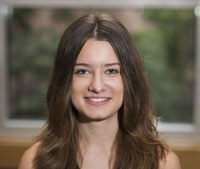 LinkedIn
LinkedIn
Educational Institution: SUNY College
List of Mentors: Dr. Qi Zhang & Kristina Kitko
Program: NSF REU
Research Project: Quantum dot-enabled tracking of single synaptic vesicle protein Synaptotagmin-1 in live neurons
Poster: NSF REU Jenna Dombroski Poster.pdf
Research Abstract: Synaptotagmin-1 (Syt-1) is a prominent synaptic vesicle protein and one of the Ca2+ sensors that triggers neurotransmitter release. Given the heterogeneity of the synaptic vesicle population and the associated variation of Ca2+ sensors, it is informative to study the distribution and mobility of individual Syt1-containing vesicles within live neurons. Quantum dots (Qdots), a.k.a. photo-luminescent semiconductor nanocrystals, possess superior optical properties ideal for single vesicle tracking. Their high quantum efficiency leads to a large signal-to-noise ratio and their photostability enables long-term tracking. Qdots were randomly tagged to single vesicular Syt-1 in live neurons via a highly selective monoclonal antibody; stimulation-induced synaptic vesicle turnover. After labeling, continuous fluorescence imaging of single Qdots was performed while neurons were continuously stimulated to induce vesicle release. Image stacks were processed in FIJI and single Qdot tracking trajectories were generated using the TrackMate plug-in.We observed significant differences (>20%) between diffusion coefficients for stimulation vs. non-stimulation using antibody-conjugated Qdots. However, there was only a 6% difference in the mean diffusion coefficients between stimulation and another control - non-specifically uptaken Qdots. Looking further into this discrepancy, we noted that there was also a significant loss of Qdots over time during field stimulation (40%). Although the effect of activity is an important cornerstone of understanding vesicle mobility, results throughout the literature remain inconsistent. Given this information, we propose that a possible explanation for the discrepancies among the literature is that when vesicles release during field stimulation, Qdots are washed away after dissociating from the antibody in the acidic vesicular environment. Future research directions involve combining Qdot imaging with dyes to specifically label synaptic vesicles, but this information holds the potential to impact the validity of results from previous findings using field stimulation.
- Jenna was awarded a NSF Graduate Research Fellowship in 2020
-
Jennifer Donohue - Mechanical Engineering, SUNY Binghamton University
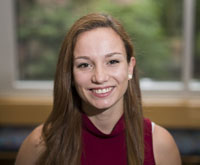 LinkedIn
LinkedIn
Educational Institution: SUNY Binghamton University
List of Mentors: Dr. Cary Pint & Kathleen Moyer
Program: NSF REU
Research Project: High Power alternative-ion batteries via co-intercalation
Poster: NSF REU Jennifer Donohue Poster.pdf
Research Abstract: The rate-limiting de-solvation step required for graphitic intercalation of alkali ions has limited the use of modern batteries in high-power technologies like grid-energy storage and electric vehicles. The co-intercalation phenomenon observed in the presence of linear ethers allows for high-power devices through co-solvate intercalation, which effectively eliminates the rate-limiting de-solvation step. This phenomenon is observed not only with conventional lithium chemistries but also with alternative ion chemistries which promise reduced battery fabrication cost. Herein, we demonstrate high-rate potassium and sodium co-intercalation into graphite with specific capacities >100mAh/g at 5A/g. Prussian blue was also investigated as a high rate cathode and in its sodiated form showed specific capacities >100mAh/g at 10C. These results prove the viability of alternative-ion co-intercalation based batteries for use in low-cost high-power applications."- Co-author Journal Publications
-K. Moyer, J. Donohue, N. Ramanna, A. P. Cohn, N. Muralidharan, J. Eaves and C. L. Pint, "High-rate potassium ion and sodium ion batteries by co-intercalation anodes and open framework cathodes," Nanoscale, 10, 13335-13342 (2018).
-A. Cohn, T. Metke, J. Donohue, N. Muralidharan, K. Share, and C.L. Pint “Rethinking Na-Ion Anodes as Nucleation Layers for Anode-Free Sodium Batteries” Journal of Materials Chemistry A, 6, 46, 23875-23884 (2018). - Conference Presentation
J. Donohue, K. Moyer, A.P. Cohn, and C. Pint “High-power alternative-ion batteries via co-intercalation”, 2018 MRS Spring Meeting & Exhibit, Phoenix, AZ, April, 2018. - Jennifer was awarded a $1K travel grant at the capstone poster session.
- Jennifer was awarded a Department of Defense National Defense Science and Engineering Graduate Fellowship.
- Co-author Journal Publications
-
Crystal Nattoo - Electrical Engineering, University of Miami
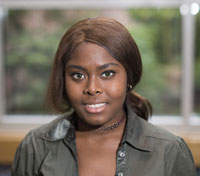 LinkedIn
LinkedIn
Educational Institution: University of Miami
List of Mentors: Dr. Sharon Weiss & Tengfei Cao
Program: NSF REU
Research Project: Porous Silicon on Glass for Low-Cost Diagnostics
Poster: NSF REU Crystal Nattoo Poster.pdf
Research Abstract: In the search for approaches to improve medical diagnostics around the globe, the World Health Organization created the ASSURED criteria: Affordable, Sensitive, Specific, User-friendly, Rapid and Robust, Equipment-free, and Delivered to those who need it. Smartphone based lab-on-a-chip systems have the potential to satisfy the ASSURED criteria because of the widespread availability of smartphones, even in low resource environments. In this work, we report on the fabrication and characterization of a new type of optical transducers for a smartphone based lab-on-a-chip system using porous silicon thin films (PSiTF). The performance of the PSiTF sensor is evaluated on different substrates with both smartphones and traditional spectrometers. Porous silicon was selected because it is a versatile material with large specific area, easy surface modification, high optical quality and low fabrication cost, which makes it a promising candidate for multi-analyte detection in our system. Preliminary sensing results based on detection of different concentrations of glucose showed that a glass-PSiTF-paper sandwiched structure exhibits reproducible optical performance in a flow-cell setting using both smartphone and spectrometer detection schemes. In the smartphone detection scheme, image processing is performed on pictures taken of the sample under test to determine color changes that result from the introduction of analyte. In the spectrometer detection scheme, reflectance spectra shifts track the introduction of analyte. Future work will focus on correlation of the smartphone and spectrometer results to benchmark detection sensitivity using the smartphone. The demonstrated glass-PSiTF-paper system has strong promise for enabling smartphone based lab-on-a-chip systems to achieve ASSURED criteria for a variety of diagnostic applications.- Co-author Journal Publication
T. T. Cao, Y. Zhao, C. Nattoo, M.H. Choudhury, and S.M. Weiss, “A Smartphone biosensor based on analysing structural colour of porous silicon,” Analyst,14 (13), 3942-3948 (2019). - Conference Presentation
T. Cao, Y. Zhao, C. A. Nattoo, and S. M. Weiss, “A Smartphone Biosensor based on a Colormetric Analysis of Porous Silicon Filters,” Porous Semiconductors Science and Technology, La Grande Motte, France, March, 2018. - Crystal was awarded Best Layout at the capstone poster session.
- Crystal was awarded a NSF Graduate Research Fellowship
- Co-author Journal Publication
-
Alexandra Quinones Melendez - Chemical Engineering, University of Puerto Rico
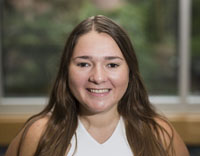 LinkedIn
LinkedIn
Educational Institution: University of Puerto Rico
List of Mentors: Dr. David Cliffel & Christopher Stachurski, Dilek Dervishogullari
Program: NSF REU
Research Project: Oriented Interface of PSI and PSII for Solar Driven Hydrogen Evolution
Poster: NSF REU Alexandra Quinones Melendez Poster.pdf
Research Abstract: In response to a growing demand for alternative energy sources, many researchers consider hydrogen fuel as a strong contender for an emissions-free and sustainable energy source. Yet current methods for hydrogen fuel production can require expensive resources or elaborate designs to function properly. Alternatively, there are a number of naturally occurring enzymatic processes with similar outcomes which could be utilized for fuel production. Photosystem I (PSI) and Photosystem II (PSII), which are the two key proteins in photosynthesis, are capable of acting in series in order to split water into hydrogen and oxygen. Our aim is to systematically functionalize both proteins allowing for their oriented assembly on a common conductive substrate, which would allow PSI and PSII to work in tandem . This work establishes a strategy to effectively short-circuit the photosynthetic pathway to sustainably generate hydrogen from sunlight in a self-contained device.- Alexandra was awarded Best Use of Graphics at the capstone poster session.
-
Sarah Ruiz - Physics, Grinnell College
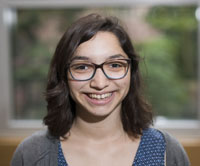 LinkedIn
LinkedIn
Educational Institution: Grinnell College
List of Mentors: Dr. Jason Valentine & Zack Coppens
Program: NSF REU
Research Project: Graphene Processing for tunable Metasurfaces
Poster: NSF REU Sarah Ruiz Poster.pdf
Research Abstract: Metamaterials enable optical properties that cannot be found in nature. Graphene has increasingly become an important component in some metamaterials due to its two-dimensional structure and potential for tunable applications. Through the use of graphene intercalation, we seek to create a tunable perfect absorber metamaterial that can be used for low power visible displays. A design for this metasurface has been developed; however, graphene processing and characterization for the design have not been fully explored. Here, we study exfoliation techniques and etch rates of graphene for fabrication of the metasurface. We characterized the etch rate for both aluminum and graphene using atomic force microscopy (AFM) to measure the step heights of graphene flakes. We found that aluminum and graphene etch at approximately the same rate of 0.8 nm/minute because of the low surface binding energy of aluminum and graphene relative to the kinetic energy of the incoming argon ions. -
Mitchell Stokan - Chemical Engineering, University of Kentucky
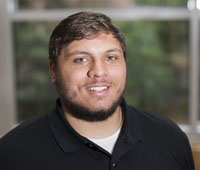 LinkedIn
LinkedIn
Educational Institution: University of Kentucky
List of Mentors: Dr. Craig Duvall & Dr. Meredith Jackson & Sean Bedingfield
Program: NSF REU
Research Project: Screening of Novel Hydrophobically Modified Triblock Copolymers for Improved Stabilization of siRNA Polyplexes
Poster: NSF REU Mitchell Stokan Poster.pdf
Research Abstract: Our lab has shown that diblock polymer-based siRNA nano-polyplexes (si-NPs), containing zwitterionic phosphorylcholine (PMPC) as the corona and a copolymer of dimethylamino ethyl methacrylate (DMAEMA), and butyl methacrylate (BMA) as the core, function as efficient vectors for siRNA delivery. These polymers possess several desirable properties including lack of toxicity, pH dependent endosomal escape, long circulation half-lives, and high levels of tumor cell uptake and silencing activity. Here, we hypothesized that a third, hydrophobic block of polypropylene sulfide (PPS), would yield si-NPs with higher stability and biocompatibility due to added hydrophobicity and core stabilization. The polyplexes were analyzed using ribogreen, luciferase, hemolysis, and fluorescence resonance energy transfer (FRET) assays to test for siRNA encapsulation, knockdown, endosomal escape, and stability respectively. The size of the nanoparticles formed were assessed using dynamic light scattering techniques by the Malvern Zetasizer. The polyplexes were tested at different N:P ratios and with or without palmitic acid hydrophobized siRNA-conjugates. Overall, the use of the polyphenylene sulfide block helped improve the encapsulation properties of the polymers and allowed for a higher efficiency in delivering the siRNA for gene knockdown. With improved stability, the polymers could be readily used for circulation in the body with less of an effect on their performance. These factors contribute to a better gene delivery system that allows for more success in drug delivery.- Co-author Journal Publication
M. A. Jackson, S. K. Bedingfield, F. Yu, M. E. Stokan, R. E. Miles, E. J. Curvino, E. N. Hoggenboezem, R. H. Bonami, S. S. Pate, P. L. Kendall, T. D. Giorgio, and C. L. Duvall, “Dual carrier-cargo hydrophobization and charge ratio optimization improve the systemic circulation and safety of zwitterionic nano-polyplexes,” Biomaterials, 192, 245-259 (2019). - Conference Presentation
M. Stokan, M. Jackson, S. Bedingfield, T. Werfel, and C. Duvall “Screening of Novel Hydrophobically Modified Triblock Copolymers for Improved Stabilization of siRNA Polyplexes” Society for Biomaterials Symposium, Atlanta, GA, April, 2018. - Mitchell was awarded a $1K travel grant at the capstone poster session.
- Co-author Journal Publication
-
Donna Xia - Chemical and Biomolecular Engineering, University of Alabama, Tuscaloosa
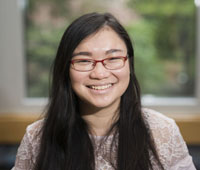 LinkedIn
LinkedIn
Educational Institution: University of Alabama, Tuscaloosa
List of Mentors: Dr. Clare McCabe & Tim Moore
Program: NSF REU
Research Project: Self-Assembly of Stratum Corneum Lipid Bilayers Via Coarse-Grained Simulations
Poster: NSF REU Donna Xia Poster.pdf
Research Abstract: The skin barrier function is localized to the lipid lamellae of the stratum corneum (SC), which is composed of ceramides (CER), cholesterol (CHOL), and free fatty acids (FFA). While this lipid composition is well-known, limited experimental resolution makes it difficult to uncover the molecular-level details of its organization. In this regard, molecular dynamics simulations offer atomic-level resolution, and can be used to study the effects of lipid composition on structural properties of SC lipid lamellae. However, the slow dynamics mean that systems are heavily influenced by their initial configurations. To bypass this effect, self-assembled structures are desirable. To reduce computational cost and allow self-assembly to be simulated, simplified coarse-grained models are used instead of their more detailed atomistic counterparts. In this study, different lipid compositions were self-assembled into bilayers, and structural properties, such as area per lipid, tilt angle, nematic order parameter, and lipid density profiles across the bilayers were examined. These properties were then compared across compositions to investigate the effects of lipid composition on bilayer structural properties.- Co-author Journal Publication
T.C. Moore, D. Xia, C.R. Iacovella, and C. McCabe, “A Course-grained Model of the SPP Structure of Stratum Corneum Lipids” Journal of the Physical Chemistry B, manuscript in preparation - Conference Presentation
T. C. Moore, D. Xia, A. C. Leonhard, C. R. Iacovella, R. Hartkamp, A. L. Bunge, C. McCabe, “Self-Assembly Simulations of Stratum Corneum Lipid Mixtures,” AIChE Annual Meeting, Minneapolis, November, 2017. - Donna was awarded a 2018 Goldwater Scholarship
- Co-author Journal Publication
